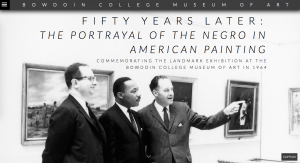Opening for Virtual Exhibit “Fifty Years Later: The Portrayal of the Negro in American Painting”

Tonight at the Bowdoin College Museum of Art, we will be hosting an opening for the virtual exhibit, “Fifty Years Later: The Portrayal of the Negro in American Painting.” As a faculty member of the Digital and Computational Studies Initiative, I played a part on the leadership team, along with Professor Dana Byrd of Art History and Curatorial Fellow Sarah Montross, to help design the architecture and structure of the site, and chime in on the shape and meaning of the site when possible. I also contributed an essay to the site which I will reblog here, and it was exciting and important work to think about who remains unrepresented and underrepresented not only in art but also who hangs in our museums. This was a new space for me to dig into and bring my work to and I appreciate the collegiality of Dana and Sarah teaching me a great deal about art and art history in the process. Click on the image to the left or here to access the exhibit.
Professor Bridget Cooks of UCLA will give a talk, “Double Consciousness: Remembering Black Images in American Struggles for Freedom,” that will be livestreamed on the Bowdoin website.
For more on the exhibit, I excerpt from Byrd & Montross’ essay on the show:
The Portrayal of the Negro in American Painting was a landmark exhibition organized by and exhibited at the Bowdoin College Museum of Art during the summer of 1964. This digital initiative examines the exhibition’s compelling yet under-recognized content and legacy. The original show included eighty paintings from over fifty prestigious museums and private collections across the United States. Featuring major works by artists such as Henry Ossawa Tanner, Thomas Eakins, Winslow Homer, and Horace Pippin, it was one of the first surveys of great American paintings that represented African-American subjects. Critically acclaimed at the time, the exhibition drew over 19,000 visitors (well beyond the number of people who usually visited the museum in an entire year). It attracted high-profile national attention, including visits and praise from Reverend Dr. Martin Luther King, Jr. and New York Governor Nelson A. Rockefeller. Organized at the height of the civil rights movement, The Portrayal of the Negro in American Painting was recognized at the time for bringing together art and sociology, showing an evolution of the portrayal and roles of African Americans in American society from the colonial period to the present.
Bowdoin College may have seemed like an unlikely venue for such an exhibition. The student body of the rural Maine college was then all-male and predominately white, and the campus was physically distant from the nexus of the civil rights movement. However, certain Bowdoin students and faculty were committed to prompting discussions of racial inequity, and were instrumental in bringing key players to campus, including Dr. King. Furthermore, the Bowdoin College Museum of Art was not known for staging major loan exhibitions before this time. The Portrayal of the Negro in American Painting was initiated by the ambitious young curator Marvin S. Sadik, who had joined the Museum in 1961. He forwarded a progressive perspective that assessed the significance of artworks by their level of political engagement. In Sadik’s view, caricature and stereotyped portrayals found in illustrations and photographs of African-Americans did not qualify as art of quality, and thus were not part of the exhibition. Sadik only included paintings that he felt conveyed a positive pictorial record of the “American Negro” that had “enriched the life and art of the nation.” Re-examining this exhibition fifty years later allows us to recognize its achievements, but also to question this curatorial approach. Because this show excluded negative portrayals of African-American subjects, what aspects of discrimination and stereotyping of African Americans in visual culture were entirely avoided? How did these elisions then shape the discourse of the exhibition’s reception in the media? By prioritizing painting, how did the exhibition neglect aspects of the lives of African Americans that were only represented in photographs or other mediums? [Click here to read more…]